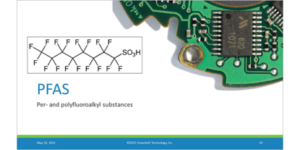PFAS
May 23, 2022 | Written by GreenSoft Technology, Inc.
PFAS Restrictions Facing Electronics Producers
 Manufacturers face various proposals restricting PFAS “Forever Chemicals” in the US and EU
Manufacturers face various proposals restricting PFAS “Forever Chemicals” in the US and EU
Concern over the dangers of Per- and polyfluoroalkyl substances, or “PFAS,” have increased exponentially in recent years.
These substances, often called “forever chemicals,” have become a popular topic in the media. And government bodies around the globe are racing to implement PFAS restrictions.
However, the nature of PFAS substances makes regulating the chemicals a complicated task, and will make the effort to comply with such regulations difficult for manufacturers.
GreenSoft Technology has published a series of educational videos on YouTube addressing the concerns and current status of PFAS restrictions around the globe. View the full paylist online.
What are PFAS "Forever Chemicals"? Where can you find a list of PFAS substances?
The term “PFAS” refers to a class of chemicals rather than a specific chemical or mixture. This makes PFAS difficult to define specifically, but the Organisation for Economic Co-operation and Development (OECD) has identified the primary distinguisher for PFAS as “a fluorinated substance that contains at least one fully fluorinated methyl or methylene carbon atom."
The nature of PFAS also makes it difficult to compile a list of PFAS substances. The OECD has identified and listed over 4,700 PFAS chemicals, while the US Environmental Protection Agency (EPA) has identified and listed over 12,000 PFAS chemicals.
PFAS substances are referred to as “forever chemicals” because they break down very slowly and accumulate in the environment and in human tissue, specifically the liver. PFAS has been detected in drinking water, food supplies, and even in newborn babies.
View or share the “What are PFAS ‘Forever Chemicals?’” video here.
PFAS restrictions facing electronics manufacturers
While currently there are no active PFAS restrictions directed at electronics producers, there are various regulatory approaches in development around the globe that could affect electronics producers in the future.
Until now, most legislative activity related to PFAS has been focused on drinking water PFAS limits and the removal of PFAS from firefighting foams. Newer restrictions have also been directed at food contact products and cosmetics.
But research and analysis of potential PFAS restrictions are ongoing globally, including in the EU, in US at the federal level, and in the US at the state level. Notably, there is a new proposal in the EU to place restrictions on all PFAS substances entirely (excluding essential uses).
The proposals have taken various approaches. Some aim to restrict a single substance (i.e. PFOS), others aim to restrict a group of PFAS substances (i.e. non-polymeric PFAS), and others aim to restrict all PFAS as a substance group (with exceptions for essential use).
View or share the PFAS Restrictions Facing Electronics Manufacturers video here.
PFAS restrictions in the European Union
There are multiple existing restrictions on PFAS in the EU stemming from various regulations. The PFAS substances restricted or pending restriction under EU REACH, EU POPs, or the Stockholm Convention include: PFOS, PFHxS, PFOA, C9-C14 PFCAs, PFHxA, HFOP-DA (Gen X), and PFBS.
Additionally, more restrictions are being proposed or reviewed:
- Some PFAS are currently undergoing REACH substance evaluation or have a harmonized classification under the CLP regulation.
- A dossier was submitted to the European Chemicals Agency (ECHA) in January 2022 to ban the use of PFAS in firefighting foams.
- 5 EU member states (Netherlands, Denmark, Germany, Norway, and Sweden) have proposed a broad ban on all PFAS usage excluding “essential uses” (which have yet to be defined). A final dossier is expected to be submitted in July 2023.
- A proposed restriction on PFHxA by Germany is now moving forward.
View or share the PFAS Restrictions in the European Union video here.
PFAS restrictions in the United States
Currently, there are no specific PFAS restrictions or regulations at the federal level in the US. However, the EPA has issued a “PFAS Strategic Roadmap” to outline the actions that it will take to address the risks of PFAS usage, including:
- Publish a national PFAS testing strategy. (Released October 2021)
- Ensure a robust review process for new PFAS. (Efforts ongoing)
- Review existing PFAS under the Toxic Substances Control Act (TSCA). (Expected Summer 2022 and ongoing)
- Enhance PFAS reporting under the Toxics Release Inventory. (Expected Spring 2022)
- Finalize new PFAS reporting under TSCA Section 8. (Expected Winter 2022)
At the state level, 20 US states have enacted PFAS drinking water standards as of March 1, 2022, and 6 states have pending PFAS drinking water standards. The water standards are not universal, so each state’s restrictions have different chemical and threshold limits.
As of this time, there are no specific regulations directed at consumer or electronic products. However, California and Washington have introduced legislation to ban PFAS in cosmetics, with six other states looking to follow. And California has added or is considering adding the following PFAS chemicals to the California Proposition 65 substances list: PFOS, PFOA, PFDA, PFHxS, PFNA, and PFUnDA.
View or share the PFAS Restrictions in the United Sates video here.
Summary
While electronics producers are not yet directly targeted by regulations on PFAS substances, future restrictions seem likely if the current trend continues.
Compliance with such regulations will be complicated due to the difficult to define nature of PFAS chemicals, and the varying and inconsistent approaches from government bodies.
GreenSoft Technology has already begun to help our customers compile their own lists of PFAS chemicals to track in their products as part of our Data Services.
We will keep a close eye on PFAS regulatory developments around the globe, and will post updates to our blog. Be sure to subscribe to our blog to receive updates in your email inbox.

